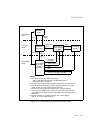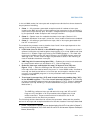
Vol. 3 17-11
8086 EMULATION
Paging is not necessary for a single virtual-8086-mode task, but paging is useful or
necessary in the following situations:
• When running multiple virtual-8086-mode tasks. Here, paging allows the lower 1
MByte of the linear address space for each virtual-8086-mode task to be mapped
to a different physical address location.
• When emulating the 8086 address-wraparound that occurs at 1 MByte. When
using 8086-style address translation, it is possible to specify addresses larger
than 1 MByte. These addresses automatically wraparound in the Intel 8086
processor (see
Section 17.1.1, “Address Translation in Real-Address Mode”). If
any 8086 programs depend on address wraparound, the same effect can be
achieved in a virtual-8086-mode task by mapping the linear addresses between
100000H and 110000H and linear addresses between 0 and 10000H to the same
physical addresses.
• When sharing the 8086 operating-system services or ROM code that is common
to several 8086 programs running as different 8086-mode tasks.
• When redirecting or trapping references to memory-mapped I/O devices.
17.2.4 Protection within a Virtual-8086 Task
Protection is not enforced between the segments of an 8086 program. Either of the
following techniques can be used to protect the system software running in a virtual-
8086-mode task from the 8086 program:
• Reserve the first 1 MByte plus 64 KBytes of each task’s linear address space for
the 8086 program. An 8086 processor task cannot generate addresses outside
this range.
• Use the U/S flag of page-table entries to protect the virtual-8086 monitor and
other system software in the virtual-8086 mode task space. When the processor
is in virtual-8086 mode, the CPL is 3. Therefore, an 8086 processor program has
only user privileges. If the pages of the virtual-8086 monitor have supervisor
privilege, they cannot be accessed by the 8086 program.
17.2.5 Entering Virtual-8086 Mode
Figure 17-3 summarizes the methods of entering and leaving virtual-8086 mode.
The processor switches to virtual-8086 mode in either of the following situations:
• Task switch when the VM flag is set to 1 in the EFLAGS register image stored in
the TSS for the task. Here the task switch can be initiated in either of two ways:
— A CALL or JMP instruction.
— An IRET instruction, where the NT flag in the EFLAGS image is set to 1.
• Return from a protected-mode interrupt or exception handler when the VM flag is
set to 1 in the EFLAGS register image on the stack.


















